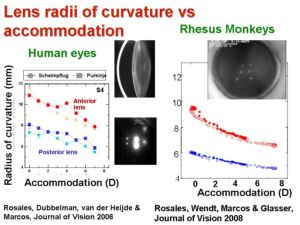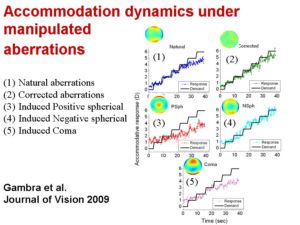The study of optical changes of the crystalline lens with accommodation and through aging is essential to understand the development of presbyopia.
We measure the optical aberrations of the crystalline lens, as well as the changes in geometry of the lens surfaces with accommodation and aging. Lens tilt and decentration of the lens is also studied.

We have measured the radii of curvature of the anterior and posterior crystalline lens surfaces as a function of accommodation in young human eyes (Rosales el at. 2006) using both Purkinje and Scheimpflug imaging, in a collaborative study with Prof. van der Heijde and Dubbelman in Amstgerdam. In addition, we used Purkinje imaging to measure dynamically the crystalline lens radii of curvature under stimulated accommodation in rhesus monkey, in a collaborative study with Prof. Adrian Glasser (Rosales et al. 2007). In that study, we also measured the changes in lens tilt and decentration with accommodation. The systematic tilt change found in one animal with increased accommodation may be related to a systematic increase in coma.

In an earlier study we had reported on the change of high order aberrations with accommodation, in particular the systematic shift of spherical aberration toward negative values, and the average overall increase of high order RMS for accommodative demands higher than 2 D (He et al. 2000). Very recently we have reported on the dynamic change (13 Hz) of ocular aberrations as a function of accommodation. Using an adaptive optics set up, we have studied the effect of manipulating the ocular aberrations on the accommodative response. We found that correcting aberrations improves the accommodative response (decreases the accommodative lag), while increasing aberrations such as coma decreases the accuracy of the response.
The fluctuations of accommodation are also altered when the accommodative demand increases, and when aberrations are corrected or induced (Gambra et al. 2009).
We are also interested in evaluating the role of gradient index distribution in the the changes of optical properties of the crystalline lens with aging and accommodation. We have developed GRIN reconstruction tomographic algorithms using LRT and OCT techniques, which we have applied to in vitro crystalline lens specimens so far.